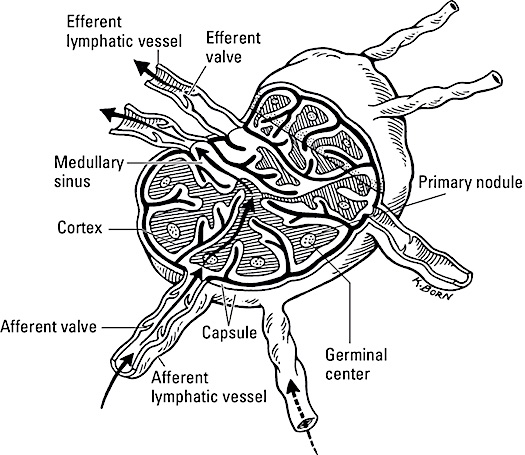 A lymph node.
A lymph node.Lymph nodes contain macrophages, which destroy bacteria, cancer cells, and other matter in the lymph fluid. Lymphocytes (a type of white blood cell), which produce an immune response to microorganisms, also are found in lymph nodes.
The indented part of each node, called the hilum, is where the efferent vessels exit and where the blood vessels (that supply the node tissue) enter and exit. Afferent vessels bring the lymph in on the convex side.
The stroma (body) of each node is surrounded by a fibrous capsule that dips into the node to form trabeculae, or septa (thin dividing walls) that divide the node into compartments. Reticular (netlike) fibers are attached to the trabeculae and form a framework for the lymphoid tissue and clusters of macrophages and B lymphocytes called lymphatic nodules.
If you have trouble remembering your afferent from your efferent, think of the “a” as standing for “access” and the “e” as standing for “exit.”
Although some lymph nodes are isolated from others, most nodes occur in groups, or clusters, particularly in the inguinal (groin), axillary (armpit), and mammary gland areas. (You can see some lymph nodes in the figure.)The following are the primary lymph node regions:
- Cervical: Found in the neck, filter lymph from the head
- Axillary: Found in armpits, filter lymph from arms and mammary region
- Supratrochlear: Found above inner elbow, filter lymph from hands
- Inguinal: Found in inguinal region, filter lymph from lower limbs and external genitalia
- Pelvic: Found in pelvic cavity, filter lymph from pelvic organs
- Abdominal: Found in abdominal cavity, filter lymph from abdominal organs
- Thoracic: Found in mediastinum, filter lymph from heart and lungs

